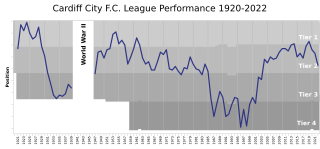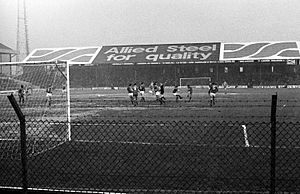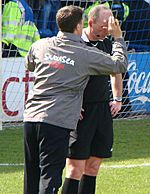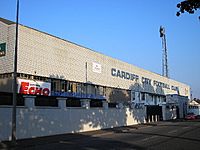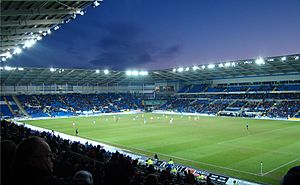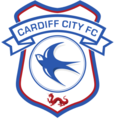Cardiff City F.C. facts for kids
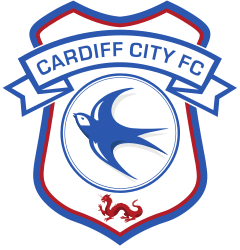 |
||||
| Full name | Cardiff City Football Club | |||
|---|---|---|---|---|
| Nickname(s) |
|
|||
| Short name | CAR, CCFC, City | |||
| Founded | 1899 (as Riverside A.F.C.) | |||
| Ground | Cardiff City Stadium | |||
| Capacity | 33,316 | |||
| Owner | Vincent Tan | |||
| Chairman | Mehmet Dalman | |||
| Head coach | Brian Barry-Murphy | |||
| League | Championship | |||
| 2018–19 | Premier League, 18th of 20 (relegated) | |||
|
||||
Cardiff City Football Club (also known as Clwb Pêl-droed Dinas Caerdydd in Welsh) is a professional football team from Cardiff, Wales. They are often called "The Bluebirds" because of their blue and white team colours.
Cardiff City was started in 1899 as Riverside A.F.C. They changed their name to Cardiff City in 1908. The club joined the English Football League in 1920. They have played in the top league of English football for 17 seasons. Their most recent time in the top league was the 2018–19 Premier League season. For the 2025–26 season, they are playing in the third tier of English football.
Cardiff City is the only team from outside England to win the FA Cup. They won it in 1927. They have also reached three other cup finals but lost them. These were the FA Cup finals in 1925 and 2008, and the League Cup final in 2012. They have won the Welsh Cup 22 times, which is a lot!
The team has mostly worn blue and white since 1908. Their first home ground was Ninian Park, which opened in 1910. They played there for 99 years before moving to the Cardiff City Stadium in 2009. Cardiff City has big rivalries with Swansea City (the South Wales derby) and Bristol City (the Severnside derby).
Contents
Club History: From Riverside to Bluebirds
How it All Started (1899–1920)
Cardiff City Football Club began in 1899. It was first called Riverside A.F.C. The idea came from Bartley Wilson, an artist in Cardiff. He wanted to keep players from the Riverside Cricket Club fit during winter.
In their first year, they played friendly games against local teams. In 1900, they joined the Cardiff & District League. In 1905, Cardiff became a city. The club then asked to change its name to Cardiff City. At first, they were told no because they weren't playing at a high enough level. To improve, they joined the South Wales League in 1907. The next year, they finally got permission to become Cardiff City.
The club grew, but they didn't have a proper stadium. This meant they couldn't join a new league called the Southern Football League Second Division. Over the next two years, Cardiff played friendly matches against big professional teams. These games helped show how much people in Cardiff wanted a strong football team.
The club eventually found land to build their own stadium, Ninian Park. It was finished in 1910. That same year, the club became professional. They signed their first player, Jack Evans, the next year.
With the new stadium, Cardiff joined the Southern Football League Second Division. They hired their first manager, Davy McDougall. He was also a player. They finished fourth in their first season. The club then hired Fred Stewart, who had more experience. He made the team more professional and signed experienced players. Stewart led the team to win the Second Division title in his second season. This meant they were promoted to the First Division. They stayed there for ten years.
Golden Years and Tough Times (1920–1945)
In 1920, Cardiff City joined the English Football League. They were placed in the Second Division. Manager Fred Stewart brought in new players. They played their first league match on August 28, 1920, winning 5–2. The team finished second that season and were promoted to the First Division. They also reached the FA Cup semi-final.
In their third season in the top league, they almost won the title. They finished second to Huddersfield Town by a tiny difference in goals.
The 1924–25 season was special because Cardiff reached their first FA Cup final. They played at Wembley Stadium for the first time. However, they lost 1–0 to Sheffield United.
The 1926–27 season was not their best in the league, but they reached the FA Cup final again! On April 23, 1927, Cardiff City made history. They beat Arsenal 1–0 in the final. This made them the only team from outside England to win the FA Cup. Hughie Ferguson scored the winning goal. The Arsenal goalkeeper, Dan Lewis, accidentally let the ball slip into the net. Captain Fred Keenor received the trophy from King George V. When the team returned to Cardiff, about 150,000 people cheered them on!
That same year, they also won the Welsh Cup. This made them the only club to win two national cups in one season. They also won the FA Charity Shield by beating the Corinthians.
After this success, the club faced harder times. They were relegated from the First Division in 1929. Two years later, they dropped to the Third Division South. In 1932, Cardiff had their biggest ever win, beating Thames 9–2. Manager Fred Stewart left in 1933 after 22 years. The club struggled and stayed in the Third Division South until World War II stopped league football.
Post-War and European Adventures (1945–2000)
After World War II, Cardiff City started strong. Under new manager Billy McCandless, they won the Third Division South in 1947 and returned to the Second Division. They were promoted to the top league again in 1952 and stayed there for five seasons. They went back down in 1957. They had another short time in the First Division between 1960 and 1962.
In the 1960s, Cardiff City played in European competitions for the first time! They qualified by winning the Welsh Cup, which allowed them to enter the European Cup Winners Cup. Their first European match was in 1964 against Esbjerg fB from Denmark. They won 1–0. They reached the quarter-finals that year.
Two years later, they reached the semi-final of the Cup Winners Cup. They beat teams like Shamrock Rovers and Torpedo Moscow. They then faced Hamburg from Germany. This is still the furthest any Welsh team has gone in a European competition. Hamburg won the game 3–2. In the 1970–71 season, Cardiff reached the quarter-finals again. They played against Real Madrid. In the first game at Ninian Park, 47,000 fans watched Cardiff win 1–0 with a goal from Brian Clark. Real Madrid won the second game, so Cardiff was knocked out.
Cardiff City spent most of the time between 1962 and 1982 in the Second Division. From 1985 to 1993, they were in the lower two divisions. In 1995, Welsh clubs playing in English leagues were stopped from entering the Welsh Cup. Cardiff's last match in the competition was a 2–1 loss to Wrexham in the 1995 final.
New Owners and Recent Times (2000–Present)
In 2000, Lebanese businessman Sam Hammam bought the club. He wanted to change the club's name to "The Cardiff Celts" and change the colours to red, green, and white. But after talking to players and fans, he decided not to change the name. The club crest was updated to include the bluebird and the Flag of Saint David.
Hammam helped the club buy new players. Manager Lennie Lawrence led Cardiff to promotion in 2003. They won the Second Division play-off against Queens Park Rangers. Andy Campbell scored the winning goal in extra time. This brought Cardiff back to Division One after 18 years.
The club faced money problems in the next few years. Plans for a new stadium were delayed. In 2007, a group led by Peter Ridsdale took over the club. In the 2007–08 season, Cardiff reached the FA Cup semi-final for the first time in 81 years. They beat Barnsley 1–0 to reach the final. But they lost 1–0 to Portsmouth in the final.

In 2010, a Malaysian group led by Datuk Chan Tien Ghee and Vincent Tan invested in the club. Tan later became the main owner. In 2011, Malky Mackay became manager. He led the team to the League Cup final in his first season. The next season, Cardiff won the 2012–13 Championship title. This meant they were promoted to the top league of English football after 52 years!
On August 18, 2013, Cardiff played their first Premier League away game against West Ham United, losing 2–0. They only won three games in the first half of the season. Manager Malky Mackay was sacked in December 2013 and replaced by Ole Gunnar Solskjær. Despite the change, Cardiff was relegated back to the Championship after just one season. Solskjær was also sacked in September 2014.

In October 2016, Neil Warnock became manager. He took the team from near the bottom of the league to a 12th-place finish. In the 2017–18 season, Cardiff broke a club record by winning their first three league games. They finished second in the table and were promoted to the Premier League again. However, they were relegated after just one season.
Warnock left in November 2019 and was replaced by Neil Harris. Harris led Cardiff to a 5th-place finish but lost in the play-off semi-final. After a series of losses, Harris was sacked in January 2021. Mick McCarthy took over but left less than a year later. The club's under-23 manager, Steve Morison, became caretaker manager and then signed a contract. Morison was sacked in September 2022 and replaced by Mark Hudson, who also lasted only four months.
In December 2022, Cardiff City faced a transfer ban from FIFA, which was lifted in January 2023. They also appealed a ban from the English Football League that stopped them from paying fees for players until May 2024.
In March 2023, Cardiff City reported a large financial loss for the 2021–22 season.
In June 2023, Erol Bulut was appointed manager. However, he was sacked in September 2024 after Cardiff started the 2024–25 Championship season with six games without a win. His assistant, Omer Riza, took over but left in April 2025. Aaron Ramsey then became caretaker manager until the end of the season. In April 2025, Cardiff City was relegated to League One. This led to fans asking for urgent talks with owner Vincent Tan.
Cardiff City Supporters
Cardiff City has many fans from Cardiff and the surrounding South Wales Valleys. Since they are a Welsh club playing in the English league, their Welsh identity is a big part of their support. Some of their matches are seen as rivalries between Wales and England.
In the 1980s, when the club was struggling, only about 3,000 people came to watch games. As the club got better, more fans started coming. Average attendance grew from 3,594 in 1997 to 12,522 in 2002. When the Cardiff City Stadium opened, average crowds reached 20,000. During their two seasons in the Premier League, between 28,000 and 31,000 fans attended games.
Welsh culture is important to the fans. Songs like "Men of Harlech" and "I'll Be There" are often sung before and during matches. "The Ayatollah" is a special celebration for Cardiff fans. It involves raising both arms up and down above the head. It became popular in the early 1990s. Many famous Welsh people, like boxer Nathan Cleverly and rugby player Gareth Thomas, have done the Ayatollah to show support for the club.
Club Rivalries
Cardiff City's biggest rivalry is with their nearby neighbours, Swansea City. This match is called the South Wales derby. They have played over 100 games against each other. The rivalry used to be friendly, but it became more intense in the 1970s and 1980s. This was due to economic problems and football hooliganism.
One game in 1993 was called "The Battle of Ninian Park" because of serious violence. This led to away fans being banned from matches between the two teams for four years. When the ban was lifted, "bubble trips" were introduced. This meant away fans could only attend games by travelling in police-escorted groups.
Cardiff also has a rivalry with Bristol City, known as the Severnside derby. They also have a smaller rivalry with Newport County. These two Welsh teams have not played each other much since the 1980s because Cardiff has usually been in higher leagues.
In the 1980s, a group of hooligans called the Soul Crew became known for fighting with rival fans.
Stadiums: Home of the Bluebirds
Ninian Park: The Old Home
Cardiff's first ground was at Sophia Gardens, where they played from 1899 to 1910. As more people supported the club, Bartley Wilson looked for land to build a proper stadium. They found a piece of waste ground on Sloper Road. It used to be a rubbish dump, so it needed a lot of work to become a football pitch. With help from the city and volunteers, the work was done.
The stadium was named Ninian Park after Lord Ninian Crichton-Stuart, who helped a lot with its building. The first match there was a friendly against Aston Villa on September 1, 1910. Lord Crichton-Stuart kicked off the game.
The stadium first had one stand. A second, much larger stand was built in 1928. Ninian Park hosted its first international match in March 1911, when Wales played Scotland. The record attendance at Ninian Park was 57,893 fans. This happened during a league match against Arsenal in 1953. The stadium closed in 2009.
Cardiff City Stadium: The New Home
In June 2009, the club finished building a new stadium called the "Cardiff City Stadium." It cost £48 million and could hold 26,828 people. Three of the stands kept the names from Ninian Park: the Grange End, the Canton Stand, and the Grandstand. The fourth stand was named the Ninian Stand.
The stadium officially opened with a friendly game against Celtic on July 22, 2009. The first competitive match was on August 8, 2009, when Cardiff won 4–0 against Scunthorpe United. The Cardiff Blues rugby team also shared the stadium for a few years but moved back to their old ground in 2012.
In August 2014, the stadium was expanded, and its seating capacity increased to 33,316. In March 2015, part of the Ninian Stand was closed for a season because not enough tickets were sold. It reopened the next year when demand increased. In February 2023, the stadium received an award for its excellent facilities for people with disabilities.
Team Colours, Kit, and Crest
Team Colours
When Riverside A.F.C. started in 1899, they wore chocolate-brown and amber checkered shirts. After changing to Cardiff City in 1908, they started wearing blue shirts with white or blue shorts and socks. For the first nine years, they wore black socks.
Over the years, the kit has changed a bit. Sometimes they wore all blue, and in the 1970s, they had a yellow stripe.
In 2012, owner Vincent Tan made a big change. He changed the home kit colours from blue, white, and yellow to red and black. This was the first time since 1908 that the club didn't wear blue as its main colour. The club crest was also changed to show the Welsh Dragon more than the bluebird. These changes were made to attract more fans from other countries. However, many fans were very unhappy and protested.
Despite what Tan had said before, on January 9, 2015, after three seasons in red, the club changed its home kit back to blue. The away kit became red. This was done to "unite" the club and its fans.
|
|
| Original strip used as Riverside A.F.C. before 1908 |
|
|
| Cardiff's original colours from 1908 until the 1920s |
|
|
| Cardiff's lighter blue strip used between 1926 and 1930 |
|
|
| Dark blue shirts returned between 1930 and 1992 |
|
|
| All blue kits were used in 1992–1996 and 2000–2007 |
|
|
| The 2009–10 strip with yellow being re-added |
|
|
| Cardiff briefly wore red between 2012 and 2015 |
|
|
| Cardiff reverted to blue during the 2014–15 season |
Club Crest History
Cardiff's shirts were plain until 1959. Then, they started using a simple crest with a bluebird. In 1969, a new crest, also with a bluebird, was introduced. Different versions of this bluebird crest have been used over the years.
In 2012, owner Vincent Tan changed the crest. The Welsh Dragon became much bigger, and the bluebird was made smaller. This was part of his plan to make the club more popular internationally. However, in March 2015, Cardiff announced a new crest. This one put the bluebird back as the main feature. A Chinese dragon replaced the Welsh dragon. In 2024, the crest was changed again for the club's 125th anniversary. The bluebird from the previous crest became the main part, inside a white circle with a blue outline.
Kit Makers and Sponsors
| Period | Kit manufacturer | Shirt sponsor |
|---|---|---|
| 1973–82 | Umbro | None |
| 1983 | Whitbread Wales | |
| 1984 | Superted
Camilleri Roofing |
|
| 1984–85 | Merthyr Motor Auctions | |
| 1985–87 | Admiral | Airways Cymru |
| 1987–88 | Buckley's Brewery | |
| 1988–89 | Scoreline | |
| 1989–90 | Havelet | |
| 1990–91 | None | |
| 1991–92 | Influence | |
| 1992–94 | Bluebirds | South Wales Echo |
| 1994–95 | Strika | |
| 1995–96 | Influence | |
| 1996–97 | Lotto | |
| 1997–98 | Errea | Gilesports |
| 1998–99 | Xara | Sports Cafe |
| 1999–2000 | Modplan | |
| 2000–02 | Ken Thorne Group | |
| 2002–03 | Puma | Leekes |
| 2003–05 | Redrow Homes | |
| 2005–06 | Joma | |
| 2006–08 | Communications Direct | |
| 2008–09 | Vansdirect | |
| 2009–10 | Puma | 777.com |
| SBOBET | ||
| 2009–10 | ||
| 2010–11 | ||
| 2011–14 | Visit Malaysia | |
| 2014–15 | Cosway Sports | |
| 2015–22 | Adidas | |
| 2022– | New Balance |
Players and Staff
First-Team Squad
|
|
Players on Loan
|
|
Retired Shirt Numbers
|
Youth Academy
Cardiff City has a youth academy for players aged seven to eighteen. Many talented players have come from this system. Some of them have even played for the Wales national team. These include Joe Ledley, Aaron Ramsey, and Rubin Colwill.
Notable Former Players
Backroom Staff
| Position | Name |
|---|---|
| Head Coach | Brian Barry-Murphy |
| Assistant Head Coach | Lee Riley |
| Head of Performance | Kevin Gibbins |
| Goalkeeping coach | Gavin Ward |
| Lead First Team Analyst | Luke Foulkes |
| First Team Analyst | Matt Jenkins |
| Data Analyst | Rob Clarke |
| Head of recruitment | Patrick Deboys |
| Head of medical services | James Rowland |
| First Team doctor | Dr. Ian Ferguson |
| Medical Director | Professor Len Noakes |
| Senior physiotherapist | Chris Lewis |
| First Team physiotherapist | Liam Donovan |
| Football Support Executive | Lee Southernwood |
Source:
Manager History
|
|
Source:
Club Records and Statistics

The player with the most appearances for Cardiff City is Billy Hardy. He played 590 matches for the club between 1911 and 1932. Phil Dwyer holds the record for most appearances in the Football League era, with 575 games.
Len Davies is the club's top goalscorer. He scored 179 goals in all competitions. Seven other players have also scored 100 or more goals for the club.
Jack Evans was the first Cardiff City player to play for his country. He played for Wales on April 13, 1912. The player who has earned the most international caps while playing for Cardiff is Aron Gunnarsson. He played 62 times for Iceland.
Cardiff's biggest ever win was 16–0 against Knighton Town in the Welsh Cup in 1962. Their biggest league win was 9–2 against Thames in 1932.
Club Honours and Trophies
Cardiff City has won many trophies over the years:
League Titles
- First Division (Top League)
- Runners-up: 1923–24
- Second Division / Championship (Second Tier)
- Champions: 2012–13
- Runners-up: 1920–21, 1951–52, 1959–60, 2017–18
- Third Division South / Third Division / Second Division (Third Tier)
- Champions: 1946–47
- Runners-up: 1975–76, 1982–83
- Play-off winners: 2003
- Fourth Division / Third Division (Fourth Tier)
- Champions: 1992–93
- Runners-up: 1987–88, 2000–01
- Promoted: 1998–99
- Southern League Second Division
- Champions: 1912–13
Cup Competitions
- FA Cup
- Winners: 1926–27
- Runners-up: 1924–25, 2007–08
- Football League Cup
- Runners-up: 2011–12
- FA Charity Shield
- Winners: 1927
- Welsh Cup
- Winners (22 times): 1911–12, 1919–20, 1921–22, 1922–23, 1926–27, 1927–28, 1929–30, 1955–56, 1958–59, 1963–64, 1964–65, 1966–67, 1967–68, 1968–69, 1969–70, 1970–71, 1972–73, 1973–74, 1975–76, 1987–88, 1991–92, 1992–93
- FAW Premier Cup
- Winners: 2001–02
Images for kids
See also
 In Spanish: Cardiff City Football Club para niños
In Spanish: Cardiff City Football Club para niños


